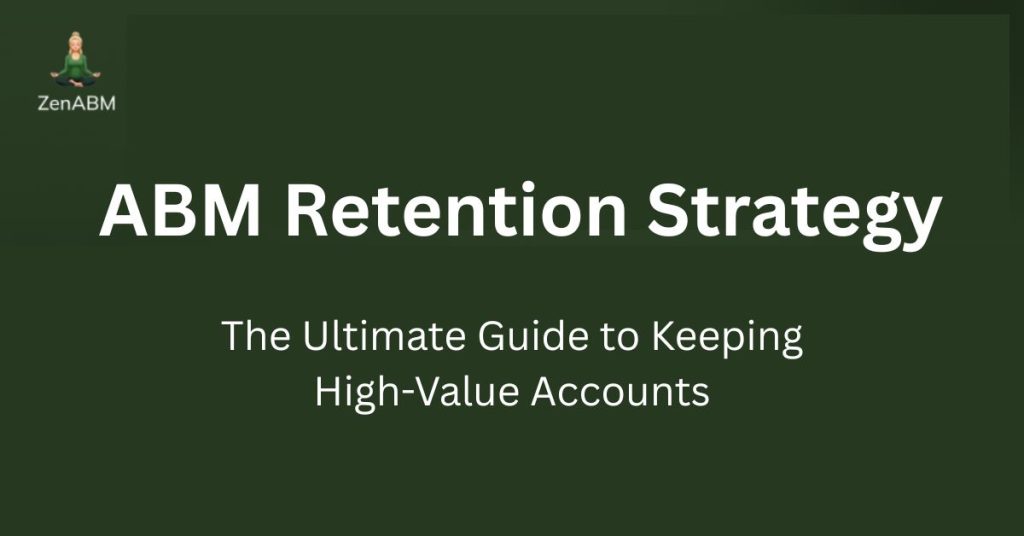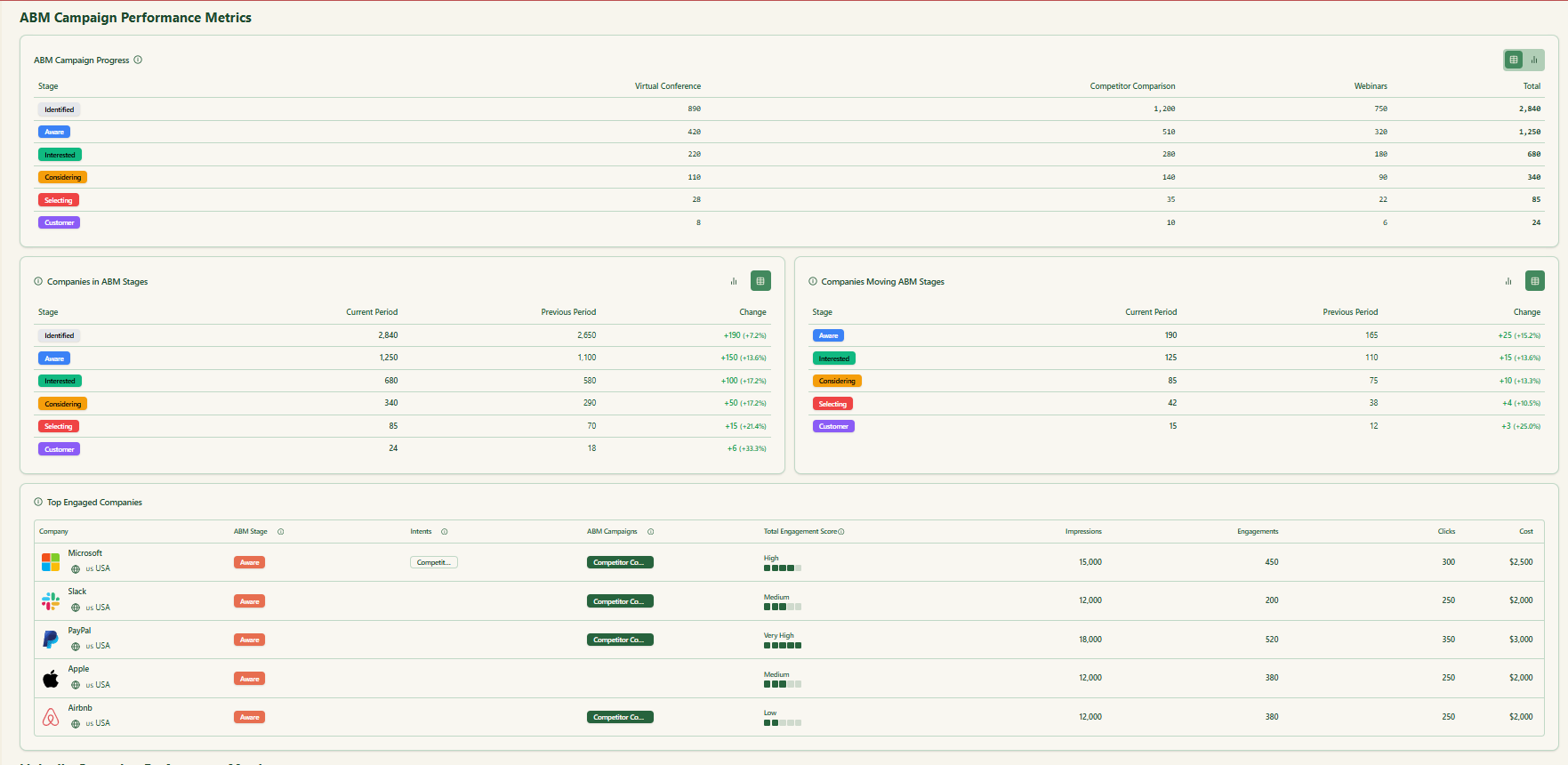Account-based marketing (ABM) isn’t just about acquiring new logos; it’s also about retaining existing ones.
So, I stalked ABM and customer retention experts, and researched other authoritative sources to bring you this ultimate ABM retention strategy guide.
I have also discussed how ZenABM can support your ABM strategy.
Read on…
ABM Retention Strategy: Quick Summary
- Retention > acquisition: Recurring revenue, lower cost, higher CLV. Treat the journey as a bow-tie/infinity loop, not a funnel.
- Full-funnel alignment: Marketing, Sales, CS, RevOps share one account view (health, usage, tickets, campaigns, renewal).
- Cross-functional cadence: Weekly pipeline/account reviews with shared retention KPIs (renewal, churn, NRR, NPS).
- ICP for expansion: Revisit ICP for customers; use product usage + benchmarks to spot high-fit expansion plays.
- RevOps automation: Time-boxed renewal workflows (120/90/60), health/usage risk alerts, playbooks baked into CRM.
- Continuous personalization: Treat customers like prospects. Go for QBRs with tailored ROI, multi-channel touches, and account-specific remarketing.
- Proactive relationship management: Frequent, value-led outreach; monitor usage/tickets/news; intervene before issues fester.
- Predict churn with AI: Daily account risk score + drivers; map drivers to plays (enablement, exec outreach, flexible ramps).
- Multi-threading: 3–5 engaged contacts per account; scorecards, exec sponsors, end-user enablement to de-risk turnover.
- Onboarding → time-to-value: Personalized onboarding, adoption KPIs, celebrate early wins to lock in habit formation.
- Upsell/cross-sell precision: Usage overage alerts, mini-ABM campaigns, right-time offers tied to outcomes and budgets.
- Advocacy flywheel: CABs, case studies, testimonials, community. Turn champions into public proof.
- ZenABM assist: Company-level LinkedIn engagement, intent tagging, CRM push, ABM stage/score, ROAS/NRR dashboards for attribution.
Why Retention is the Real Game (and Acquisition Is Only Half the Battle)
Ask any revenue leader over 50 with battle scars in B2B: they’ll tell you today’s growth comes from expanding and retaining existing accounts and not just chasing new ones.
This is especially true for businesses operating on a recurring revenue model, where up to 70% of revenue can be generated after the initial sale.
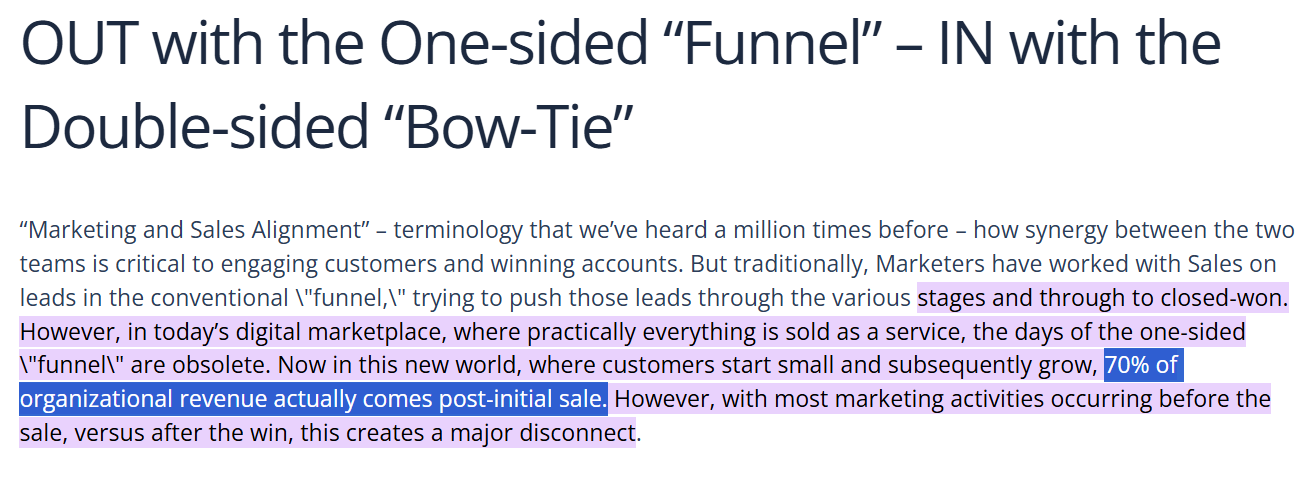
Additionally, customer retention is approximately five to seven times less expensive than customer acquisition, according to Forbes.
You can visualize this approach like a double-sided bow tie (and not a funnel that ends at acquisition).
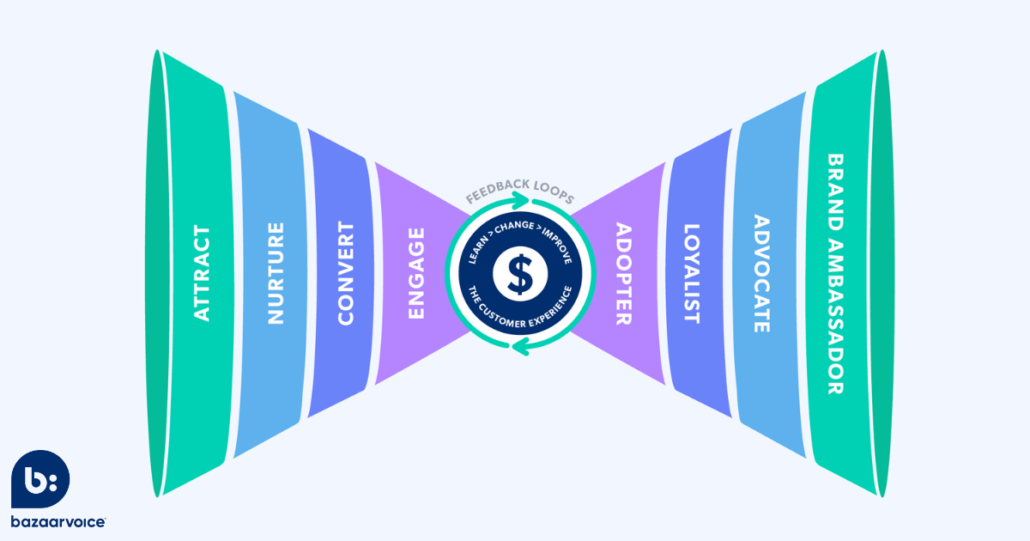
With all this said, the reality is that customer retention and expansion are still not taken seriously by marketers, and the burden is thrown on customer success teams alone (most small businesses don’t even have this department!).
My advice?
Drop the outdated “funnel” mindset and think in terms of a bow-tie or infinity loop where the customer journey never ends, and don’t shy away from using ABM for this approach.
Foundation of ABM Retention Strategy: Full-Funnel ABM Alignment
Before you unleash advanced tactics, get your house in order 🙂
I’m talking about the alignment of your marketing, sales, and customer success teams.
ABM retention strategy demands tight orchestration across departments. No more passing the baton at closed-won and hoping customer success “handles” it. Everyone from the SDR to the CSM to the RevOps analyst should be rowing in the same direction with the same intel.
Establish a Single View of the Account
Establish a single view of each account in your CRM and tear down the walls.
Ensure marketing can see product usage and support tickets, sales can see campaign engagement, and customer success sees everything from day one. A shared account dashboard with status, health score, renewal date, open opportunities, and recent activities is a must.
Invest in RevOps and tools that unify these data streams (it pays off).
ZenABM, for instance, pulls all the LinkedIn ad engagement data at the company level and pushes it as a company property to your CRM automatically:
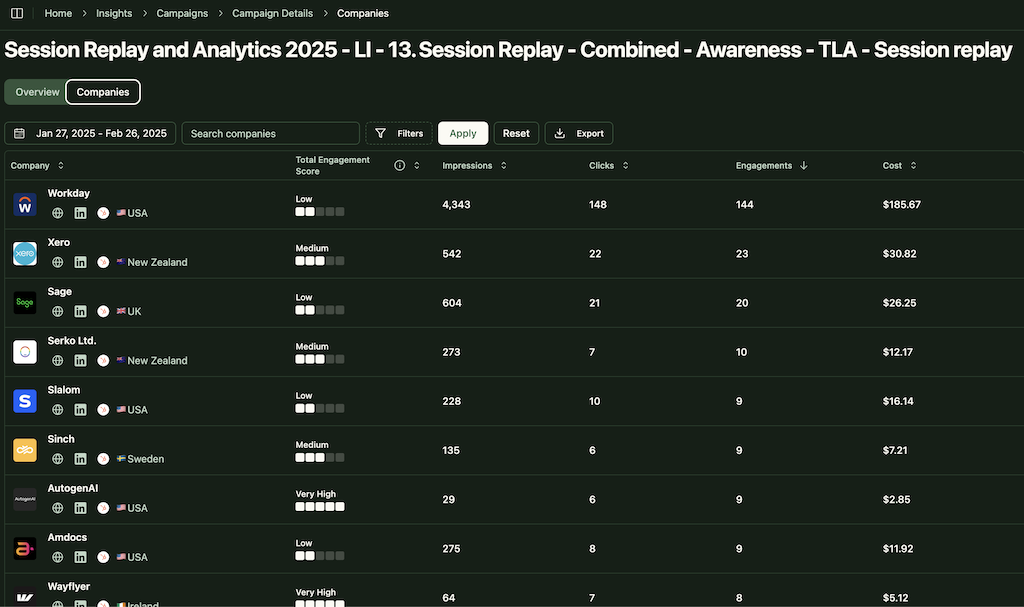
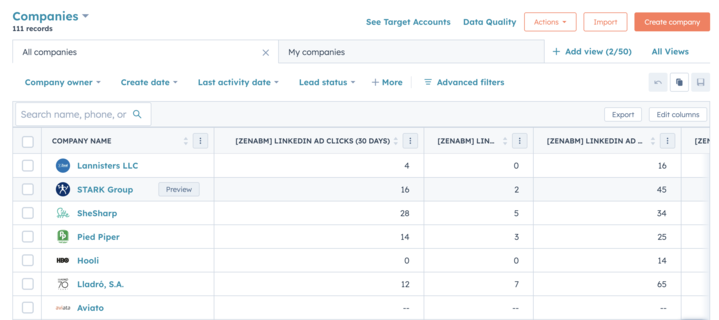
So, your sales and customer success teams don’t even need to log in to ZenABM. All’s available in the CRM.
Conduct Regular Cross-Functional Check-Ins
Regular cross-functional check-ins are, I’d say, a must and include weekly pipeline and account review calls where marketing, sales, and CS leads huddle on the same numbers.
These meetings ensure everyone knows who’s targeting which accounts and why. If Marketing is still patting itself on the back for MQLs while Sales chases bookings and Success is scrambling at renewal time, you’re doing it wrong. Instead, define shared KPIs that actually matter for retention: churn rates, renewal rates, account growth, Net Promoter Score, net revenue retention, etc.
Align on the Ideal Customer Profile and Account Selection
Bake alignment into your Ideal Customer Profile and account selection.
Don’t just hand Sales a target list and disappear.
Collaborate to refine which accounts have high expansion potential or fit your product’s sweet spot for adoption.
Pro Tip: The best ABM practitioners revisit their ICP for existing customers, not just prospects. For example, if you sell a multi-module SaaS platform, your ICP for expansion might be customers using Module A heavily who could benefit from Module B. Use product usage data and industry benchmarks to flag these opportunities. Identify growth opportunities continuously. E.g. a manufacturing client showing increased output might need more of your solution, or a SaaS client hitting user limits might be ripe for an upgrade.
Set Up a Revenue Operations (RevOps) Framework
Finally, empower a Revenue Operations (RevOps) framework to operationalize all this.
RevOps can automate the workflows that ensure no account falls through the cracks.
For instance, the RevOps team at LeanData runs an automated renewal play: 120, 90, and 60 days before an account’s renewal date, they check if a renewal opportunity is in the proper stage. If not, the account manager personally reaches out.
On the flip side, they have also set up churn risk alerts like health score drops, usage dips, or other risk factors flagged in CRM.
The takeaway: Systematize your retention workflow. Don’t wait until 30 days before renewal to scramble; bake proactive retention plays into your cadence (I’ll cover more plays shortly).
Super-Tactical ABM Retention Strategy Plays
Enough preaching.
Let me show you the tactics now:
1. Treat Your Customers Like Prospects (Continuous Personalization)
Yes, you read that right. The deal might be closed, but in ABM, a customer is never “closed.”
You market to them continually as if you’re still trying to win their business. In a way, you are, right?
- This starts with deep account research even after they sign. Maintain an up-to-date profile of each customer’s goals, challenges, industry trends, and usage of your product. Feed this insight into ongoing outreach. For example, quarterly business reviews (QBRs) shouldn’t be generic. They should be hyper-personalized strategy sessions. If you’re a SaaS provider, enhance your QBR decks with personalized performance metrics that tie directly to the customer’s KPIs. Show them you understand their business better than anyone.
- Keep the content flowing. Create a stream of truly relevant content for existing accounts: advanced best practice guides, exclusive research, benchmark reports, case studies from peers, etc. And don’t spam it; personalize it. If Account X is struggling to improve the Y metric, send them a whitepaper or a short video addressing exactly that.
- Also, multi-channel is not just for prospects. Use the full mix to engage customers. That means targeted ads (yes, keep serving them ads highlighting new use cases or offers), email nurtures for new features, direct mail for special occasions, and in-person touchpoints when possible.
- An underrated play: create customer-specific remarketing audiences in your ad platforms. Then deliver ads with tips, product updates, or case studies to users at that account.
Pro Tip: Dedicated customer newsletters featuring highly curated content for users of your product. This isn’t your generic marketing newsletter. It’s more akin to an elite insider brief. Share industry news, how-to articles, and (subtly) your product’s latest capabilities. Position it as an “exclusive” resource. People love feeling like they’re part of a special club of power users. And if you can spotlight one customer’s success story in each issue, even better. Peers learn from peers.
2. Proactive Customer Relationship Management (Don’t Wait for Problems. Prevent Them)
Quality, pricing, and similar factors only come later in the list.
Most churn is primarily due to neglect (as in bad customer service).
In fact, Forum Corporation’s research puts the number of churn cases caused by poor customer service at 70 out of every 100:
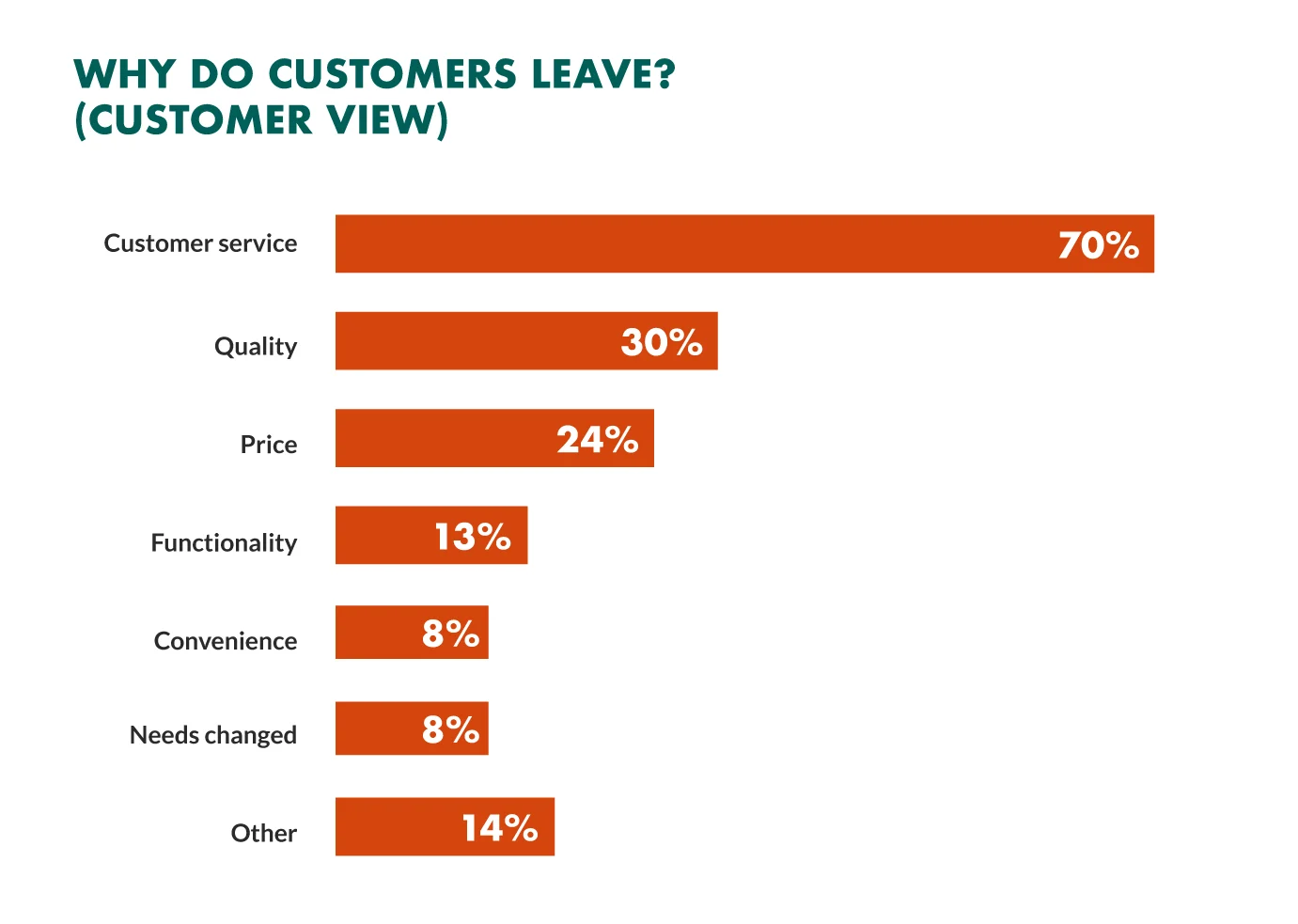
So, ABM champions are proactive, almost to the point of paranoia, about heading off customer issues before they fester.
And you must be too:
- First, institute regular check-ins and executive outreach. This isn’t just the CSM’s quarterly call. I’m talking multi-layered, frequent touches. At a minimum, schedule monthly touchpoints with power users and stakeholders at the account (alternating between the CSM, the account executive, and even a leadership sponsor from your side for big accounts). These are not status calls to “see how things are.” They are value-driven discussions to surface needs and keep the partnership strong.
- Use these meetings to share a new insight, a new idea, or to address any brewing concerns. Never let the silence build. A customer should never wonder, “Hey, where have they been?” If they do, a competitor’s whisper can suddenly sound enticing.
- Also, utilize data. Set up alerts on any significant drop-offs in product usage and engagement metrics. If a customer’s logins or usage dips for two weeks straight, trigger an internal alarm for the account team. Combine that with other signals: support tickets (a spike in issues or unanswered tickets is a red flag), customer health score if you have one (e.g. Gainsight or your internal scoring), or even external news (leadership changes, budget cuts at the client org). For example, if data shows a customer isn’t using a module they bought, don’t wait. Reach out and offer additional training or troubleshoot why adoption is low.
Pro Tip: Build your own churn prediction model. Your RevOps can do this. Start by unifying product, CRM, billing, and support data, engineering features (feature adoption, seat utilization, ticket volume, payment anomalies) and training a churn model that outputs a daily account-level risk score with top drivers. Segment by risk and tie each driver to a playbook: low adoption → enablement sprint, competitor interest → 1:1 ads + exec outreach (yes, here’s where ABM will come into the picture), ROI-time concerns → flexible ramp. Use AI to auto-draft personalized emails/success plans/in-app nudges and recommend next-best actions per account; let a simple bandit optimize offers and content. Close the loop by tracking adoption lift, renewal rate, and NDR, and retrain the model monthly.
3. Multi-Thread and Build Deeper Relationships
No customer is ever “safe” if your relationship is limited to one or two contacts.
People change jobs, and priorities shift.
If your champion leaves and you haven’t cultivated other allies in the account, your position is on thin ice.
That’s why ABM retention strategy demands multi-threading to develop relationships with multiple stakeholders across the account, vertically and horizontally.
What does this mean in practice?
- Map the org chart for every high-value account. Identify influencers, decision-makers, end users, and executives, and plan sustained engagement across all of them.
- Sales and CS handle day-to-day; marketing supports with persona-specific content. While the CSM works with the department manager, you can run account-specific ads or send emails to the VP/C-suite with thought leadership. You can also invite execs to VIP dinners, share relevant industry reports, give end users training webinars or provide community access. Surround the account so that if one contact goes dark, others still see value.
- Tactically, set relationship-depth goals. Within six months of onboarding, secure 3–5 engaged contacts. Use Account Plans to document targets (e.g., Primary Champion: Director; Secondary: VP; Executive Sponsor: CFO has seen ROI deck) and track touches: last VP meeting, CFO invited to the customer advisory board, end-user feedback captured. Make it someone’s job (AM/CSM) to keep expanding contacts; many ABM teams use relationship scorecards.
- Multi-threading also drives expansion. To cross-sell into other departments, build relationships there early.
Bottom line: Don’t rely on one contact. Spread relationship capital so users through VPs have active ties to you. Renewals become smoother because multiple people vouch for your value. This is ABM retention strategy 101 – proactively embed many-to-many relationships so replacing you is hard when half a dozen stakeholders see you as essential.
4. Onboarding and Adoption: Speed to Value or Bust
A smooth, strategic onboarding is absolutely an ABM issue, and not just the headache of CS.
And the goal in onboarding is simple: get customers to value (the “aha” moment) fast.
In fact, companies with structured, well-executed onboarding see a 10% increase in customer retention in the first six months.
That’s huge. So work with your implementation and CS teams to tighten this up.
- If you can, create personalized onboarding plans for each account segment.
- For complex B2B solutions, assign a dedicated onboarding specialist or team for high-value accounts (yes, that’s extra cost, but consider it an investment in long-term revenue).
From an ABM perspective, consider creating onboarding campaigns that run alongside the CS-led training.
- For example, while your CS team does the technical knowledge transfer, your marketing can send a “Welcome Kit” or a drip of content to new users at that account.
Remember, if users don’t adopt the product, they churn. Period. So treat product adoption metrics (feature usage, frequency, depth of use) as ABM retention strategy KPIs, not just CS metrics.
Pro Tip: Celebrate early wins in the adoption phase. When the customer achieves their first milestone, say, 30 days in, and they’ve completed implementation or hit a usage goal. Celebrate it. As cheesy as it sounds, send congratulations emails or use gamified elements. Asana does this pretty well:
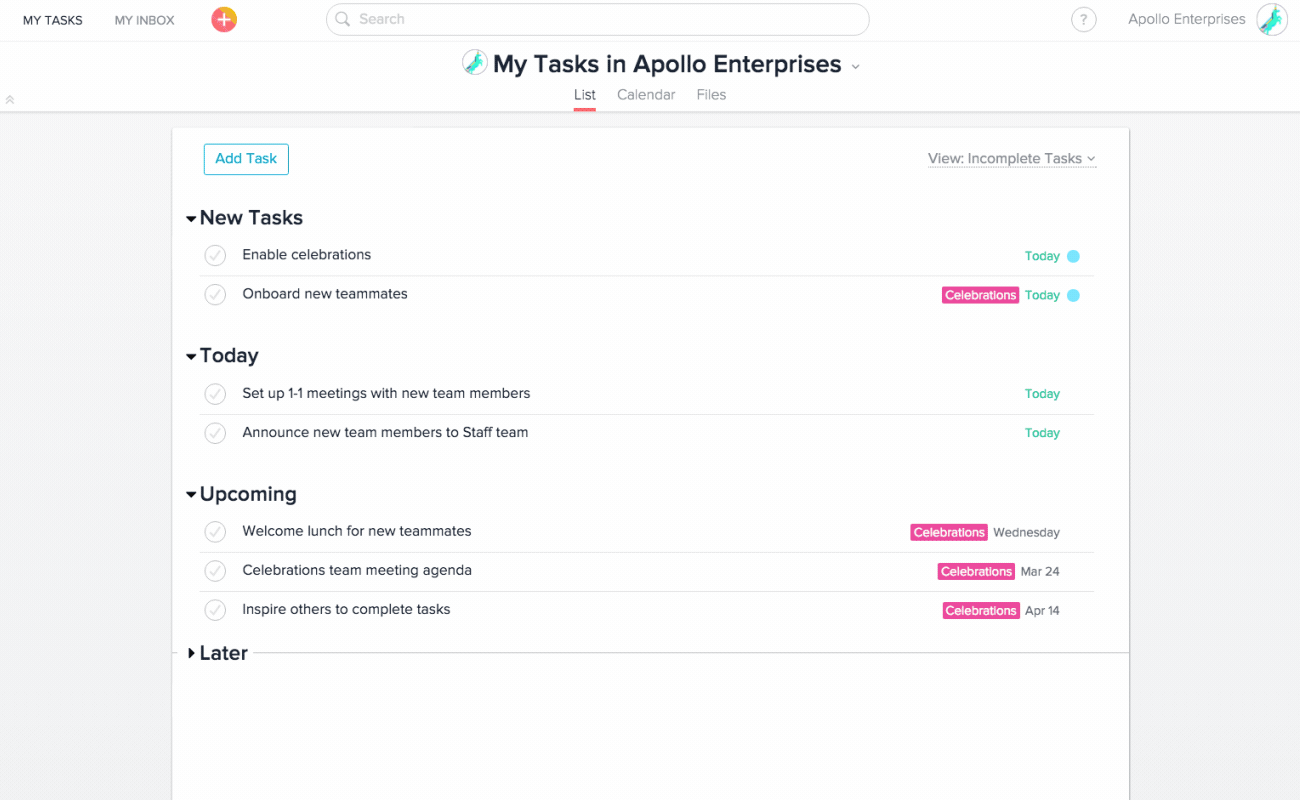
5. Driving Upsells and Cross-Sells with ABM Precision
Retention isn’t just about keeping the status quo. It’s also about growing the account.
A true ABM expert isn’t satisfied with 100% renewal; they’re aiming for 130%, meaning each account renews and expands.
Upsells and cross-sells are the turbochargers of your retention strategy, converting customer success into more revenue.
And guess what?
ABM retention strategy gives you the perfect toolkit to do this without being salesy.
First, identify expansion opportunities from your data and your customer’s context.
If you have multiple product lines or tiers, figure out which ones each customer doesn’t have yet but could genuinely benefit from.
Look at their industry peers or benchmarks and see if they are under-utilizing something others find valuable?
Use all this intel to pitch upsells that will actually solve the customer’s evolving needs, not feel like random add-ons.
Examples:
- Usage Overage Alerts: If you meter seats/API calls, monitor thresholds and overages. Why? Because if they’re using more than they bought, they likely need to upgrade to a higher tier or buy more capacity. Then show them ads about your higher tiers and how those higher-tier subscriptions might actually be cheaper than overage charges.
- Account Expansion Campaigns: Treat upsells like mini-ABM. For example, if you want to cross-sell a new module, don’t rely on one salesperson’s phone call. Coordinate a sequence. Start with targeted content sent to the account about that module’s benefits, perhaps a case study of another customer who got value from it, followed by a personalized email or LinkedIn message from an executive or product expert offering to discuss how it could help them. Use multi-channel touches to warm them up (and utilize the existing trust you have with them).
Also, be considerate of the timing. Align offers with logical moments like post-success, project kick-off, or new budgets. Please don’t wait for them to ask; by then, you’ve missed evaluation cycles. Instead, deliver data-driven, personalized recommendations like “You’re heavy users of Core, not XYZ (in higher tier); peers use it to achieve ABC; let’s discuss acceleration.”
6. Cultivate Advocacy and Loyalty (Turn Customers into Fans)
The final stage of the ABM retention strategy is turning your clients into advocates.
How to do it?
-
- Delight them with surprises! I’m talking about gifts, customer appreciation events. etc.
- Also, you can implement a Customer Advisory Board (CAB). Invite senior stakeholders from your key accounts to join this panel that meets a couple of times a year to discuss your roadmap, give feedback, and network with each other. This is gold: it makes customers feel heard and important (“the company is literally seeking my advice!”), and it often cements their commitment because they become invested in your success, too.
- Encourage and facilitate advocacy opportunities: case studies, testimonials, speaking opportunities, referrals. But approach this as recognition for the customer, not just favors for you. When you create a case study about their success, it doubles as internal publicity for your champion (they get to be the hero who chose you and drove results). Win-win. Some companies even have formal advocacy programs (with incentives, swag, reward points, etc.).
- Community building works, too. Connect customers via forums, user groups, Slack, or meetups. People bond over shared challenges; a brand-run community raises psychological switching costs. Customers don’t just use a product; they belong to a movement. Sangram Vajre (Terminus) did this with #FlipMyFunnel, turning customers into evangelists.
Remember: Loyalty is not just prudent, but also emotional. All the rational benefits in the world (ROI, features, etc.) only get you so far; it’s the emotional connection that produces true loyalty. ABM’s personal touch, the constant value delivery, the feeling that “these guys have our back and really care about our success” – that’s what creates an emotional bond.
ZenABM for LinkedIn Ads ABM Retention Strategy
If you detect that an account can be upsold/cross-sold to, ZenABM can help you here.
You can first study what offer/feature will entice the customer, and then show them relevant ads on LinkedIn. With ZenABM, you’ll be able to see if the account is engaging with those ads:

If you are showing them multiple ads with different intents, you can track which intent has the most popularity with a particular account:
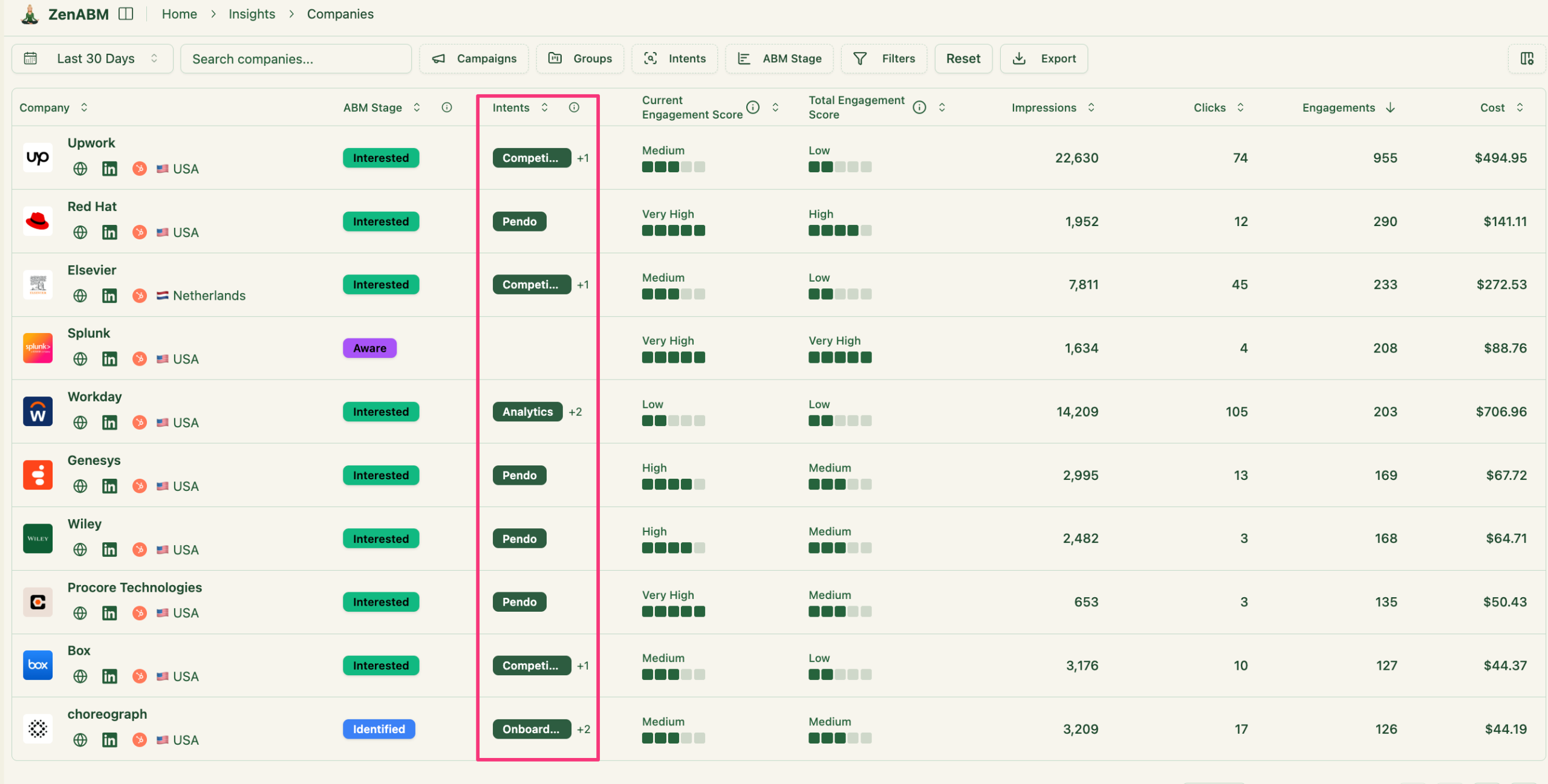
This will help you in knowing exactly which feature or upgrade you should talk about in your cross-selling or upselling pitch, respectively.
Plus, ZenABM matches engaged companies to the deals in your CRM, so you’ll get advanced dashboards showing if your ads really had an impact and how much:
Conclusion: A Solid ABM Retention Strategy is Your Competitive Edge
Retention is your unfair advantage. Now operationalize it!
Use ZenABM to spot intent, prioritize accounts, and prove impact while your team runs personalized save/expansion plays.
Next steps: Book a 30-minute ZenABM demo, ship your first customer-only LinkedIn campaign this week, and stand up a renewal/risk dashboard in your CRM. Let’s turn renewals into NRR with a solid ABM retention strategy powered with ZenABM.

